
Sutton Hoo is the site of two Anglo-Saxon cemeteries dating from the 6th to 7th centuries near Woodbridge, Suffolk, England. Archaeologists have been excavating the area since 1938, when an undisturbed ship burial containing a wealth of Anglo-Saxon artifacts was discovered. The site is important in establishing the history of the Anglo-Saxon kingdom of East Anglia as well as illuminating the Anglo-Saxons during a period which lacks historical documentation.
Reutlingen, nicknamed "The Gate to the Swabian Alb", is a Landkreis (district) in the middle of Baden-Württemberg, Germany. The former free imperial city reached the limit of 100,000 residents in 1989. It is the ninth-largest city in Baden-Württemberg. Reutlingen district's neighboring districts are Esslingen, Göppingen, Alb-Donau, Biberach, Sigmaringen, Zollernalbkreis, Tübingen and Böblingen.
The Zollernalbkreis is a Landkreis (district) in the middle of Baden-Württemberg, Germany. The district is located in the Swabian Alb, and contains the second highest elevation of this range, the 1,011-metre (3,317 ft) high Oberhohenberg. In the south-east the district nearly reaches to the river Danube.

Allmersbach im Tal is a municipality in the Rems-Murr district of Baden-Württemberg, Germany. It belongs to the Stuttgart Region and to the boundary area of the Stuttgart Metropolitan Region.

Hohenasperg, located in the federal state of Baden-Württemberg near Stuttgart, Germany, of which it is administratively part, is an ancient fortress and prison overlooking the town of Asperg.

Plochingen is a town in the district of Esslingen in Baden-Württemberg in southern Germany. It lies on the river Neckar, on which it has a river port. With about 14,000 inhabitants, it is part of the Stuttgart Metropolitan Region.
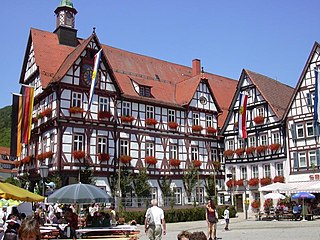
Bad Urach is a town in the district of Reutlingen, Baden-Württemberg, Germany. It is situated 14 km east of Reutlingen, at the foot of the Swabian Jura, and is known for its spa and therapeutic bath.
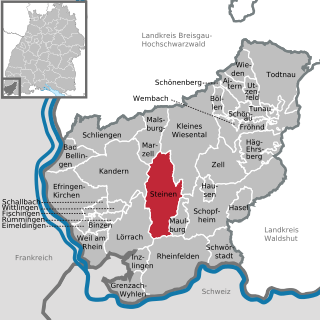
Steinen is a municipality in the district of Lörrach in the southwest of Baden-Württemberg, Germany. It is situated on the river Wiese, 15 km northeast of Basel, and 6 km northeast of Lörrach.

Reute is a municipality in the district of Emmendingen in Baden-Württemberg, Germany.
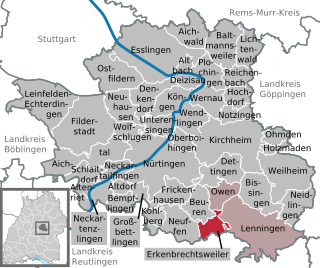
Erkenbrechtsweiler is a municipality in the district of Esslingen in Baden-Württemberg in southern Germany.
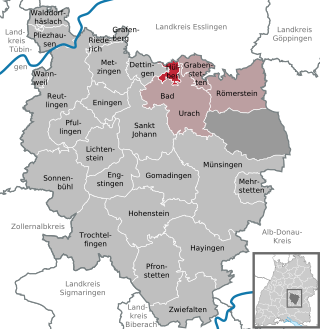
Hülben is a municipality in the district of Reutlingen in Baden-Württemberg in Germany.
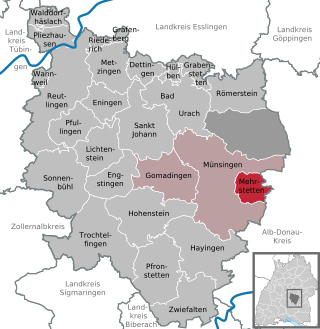
Mehrstetten is a municipality in the district of Reutlingen in Baden-Württemberg in Germany. It is located seven kilometers southeast of Münsingen.

Pliezhausen is a municipality in the district of Reutlingen in Baden-Württemberg in Germany.

Kirchentellinsfurt is a municipality in the district of Tübingen in Baden-Württemberg in Germany, about 7 km east of the city of Tübingen and 7 km northwest of Reutlingen. Since 2015, Bernd Haug has been the mayor of Kirchentellinsfurt.
Albert Maier was the founder of the German Christadelphians.
The Plochingen–Immendingen railway is a main-line railway line in the German state of Baden-Württemberg. It runs from Plochingen via Horb am Neckar to Immendingen, following the upper reaches of the Neckar from Plochingen to Neckartailfingen and from Kirchentellinsfurt to Rottweil, and finally the Danube from Tuttlingen to the end of the line. It was therefore also historically known as the Obere Neckarbahn or the Obere Neckartalbahn. The Rottweil-Immendingen section used to be called the Obere Donaubahn or Obere Donautalbahn.

The Tangendorf disc brooch is an Iron Age fibula from the 3rd century AD, which was dug up in 1930 from the sand of a Bronze Age tumulus near Tangendorf, Toppenstedt, Harburg, Lower Saxony, Germany. The front of the elaborately crafted garment fibula is decorated with a rear-facing four-legged animal, probably a dog or a deer. It is one of Harburg's most important finds from the period of the Roman Empire, and is in the permanent exhibition of the Archaeological Museum Hamburg in Harburg, Hamburg.

The Maschen disc brooch is an Early Medieval fibula, which was found in 1958 during archaeological excavations of the late Saxon grave field near Maschen, in the Lower Saxony district of Harburg, Germany. On its face side, the fibula shows an unidentified saint with a halo. It was found in a woman's grave of the beginning of the Christianization of northern Germany, and is in the permanent exhibition of the Archaeological Museum Hamburg in Harburg, Hamburg.

Heidengraben is the name given to the remains of a large Celtic fortified settlement (oppidum) dating to the Iron Age, located on the plateau of the Swabian Jura in the districts of Reutlingen and Esslingen in Baden-Württemberg, Germany. The settlement was in use from the 2nd century BC to 1st century BC, during the La Tène period. By surface area, Heidengraben is the largest oppidum in all of mainland Europe.

A disc fibula or disc brooch is a type of fibula, that is, a brooch, clip or pin used to fasten clothing that has a disc-shaped, often richly decorated plate or disc covering the fastener. The terms are mostly used in relation to the Middle Ages of Europe, especially the Early Middle Ages. They were the most common style of Anglo-Saxon brooches.


















